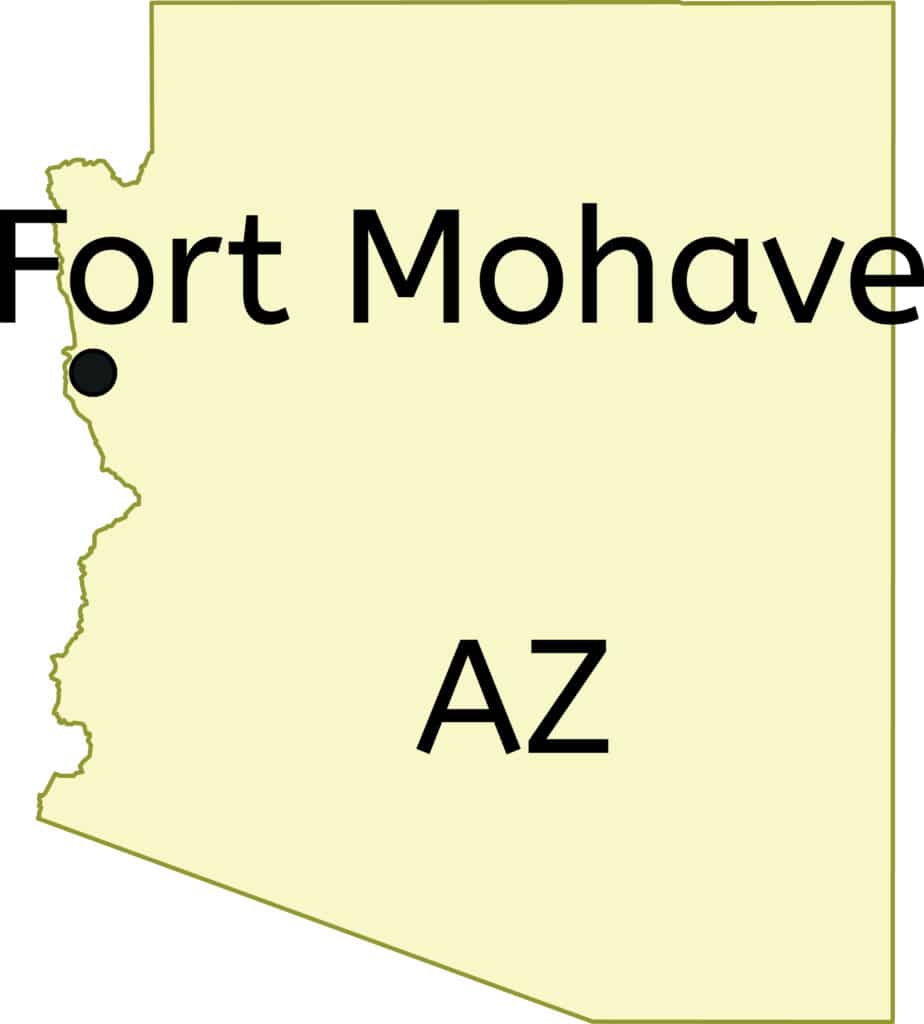The unforgiving desert sun beats down on scattered ruins and weathered foundations where Fort Mohave once stood sentinel along the Colorado River. Today, only fragments remain visible—a crumbling stone wall here, the faint outline of a foundation there—silent witnesses to a military outpost that once represented the farthest reach of American authority in the Southwest. Located near present-day Mohave Valley, approximately 15 miles north of Needles, California, this remote fortress once buzzed with the activity of soldiers, settlers, and indigenous peoples navigating complex relationships along a contested frontier. The fort’s cemetery, with its weathered markers slowly sinking into desert sands, and the ghostly echoes of newspaper accounts and steam whistles from long-departed riverboats and trains, tell stories of ambition, hardship, and the fleeting nature of human endeavors in this harsh but beautiful landscape.

The Colorado River is the centerpiece of recreation in Fort Mohave. Visitors can swim, fish, paddleboard, kayak, or simply relax along the riverbanks. The clean, cool water is especially inviting in the warmer months and offers a refreshing contrast to the surrounding desert landscape.
The original Fort Mohave was established in 1859 to protect travelers and settlers along the Fort Mojave Road. Though little remains of the actual fort, the area is historically significant as part of the U.S. Army’s expansion into the western frontier and early interactions with the Mojave people. Plaques and markers offer insight into its past.
This scenic championship golf course is a local favorite, offering lush fairways, a beautiful clubhouse, and views of the surrounding mountains and desert. Los Lagos is suitable for all skill levels and is open year-round, thanks to Fort Mohave’s warm climate.
Just a short 15-minute drive away, Laughlin offers casinos, live entertainment, riverside dining, and shopping. It’s an ideal spot for those wanting to add a bit of nightlife or resort-style amenities to their visit.

Launch your boat or rent jet skis at nearby marinas like those in Bullhead City or Needles, CA. The wide, calm stretches of the Colorado River are perfect for water sports and leisurely cruising.

Operated by the Fort Mojave Indian Tribe, the Avi Resort & Casino offers slot machines, a movie theater, restaurants, a beach area, and live shows. It’s a great all-in-one spot for a fun evening or weekend getaway.

Just to the west lies Spirit Mountain, sacred to local tribes and full of rugged hiking trails, petroglyphs, and panoramic desert views. This area offers fantastic opportunities for outdoor enthusiasts to explore the desert’s natural and cultural richness.

The surrounding Mojave Desert is a haven for ATV and off-road vehicle enthusiasts. Numerous trails and open desert roads provide opportunities to explore old mining roads, washes, and scenic vistas. Be sure to bring plenty of water and a GPS.

Fishing is a popular and relaxing pastime along the Colorado River. Anglers can catch bass, catfish, bluegill, and trout, especially near calm coves and inlets.
Lieutenant George Hartsuff’s tenure as Fort Mohave’s commander from 1859 to 1861 illustrated the complex relationships between military authority and indigenous sovereignty. Hartsuff, educated at West Point and bearing wounds from earlier service in Florida, approached his assignment with a combination of military discipline and pragmatic diplomacy. His correspondence, preserved in military archives, reveals efforts to establish working relationships with Mohave leaders while maintaining the forceful presence his superiors expected.
Hartsuff’s journals describe regular councils with Aratêve, an influential Mohave leader who navigated the difficult position of maintaining his people’s interests while avoiding direct conflict with American forces. Their conversations, sometimes lasting hours and conducted through imperfect translation, ranged from practical matters of river passage to philosophical discussions about the nature of territorial rights and governance. When Hartsuff received transfer orders at the outbreak of the Civil War, Aratêve reportedly presented him with a meticulously crafted wooden staff as a symbol of respect—an object now preserved in the Arizona Historical Society collections.
Francisco Márquez, who operated steamboats on the Colorado River from 1864 until 1879, connected Fort Mohave to the wider world through river commerce. Born in Sonora, Mexico, Márquez began as a pilot navigating the treacherous channels and sandbars of the Colorado before eventually acquiring his own vessel, the Río Colorado. His detailed knowledge of the river’s changing patterns proved invaluable to both military and civilian transport. Márquez maintained detailed logs of water conditions, navigation hazards, and shipping manifests that now provide historians with invaluable information about commerce and transportation in the region. His home near the steamboat landing became known for hosting multicultural gatherings where Mohave tribal members, soldiers, and civilians shared meals and music—a rare example of cross-cultural community in an often-divided frontier society.
Sarah Bowman, known widely as “the Great Western” from her earlier fame during the Mexican-American War, operated a boarding house and restaurant near Fort Mohave in the 1860s. Already legendary for her impressive physical stature, cooking skills, and tendency to wear pistols while serving meals, Bowman brought colorful frontier character to the fort community. Military records mention her establishment as “a rare outpost of civilized comfort,” where officers gathered for meals superior to standard military fare. Bowman’s facility served simultaneously as dining establishment, unofficial mail station, and community meeting place until her death in 1866, after which she received a military funeral with full honors—reportedly the first woman to be so recognized at a frontier post.
| Category | Details |
|---|---|
| Name | Fort Mohave, Arizona |
| Type | Former military fort / active community |
| County | Mohave County |
| Founded (as fort) | 1859 (as Camp Colorado; renamed Fort Mohave in 1859) |
| Status | Fort abandoned in 1890; community of Fort Mohave is active today |
| Population (Current) | ~16,000 (2020 census for Fort Mohave CDP) |
| Historical Significance | U.S. Army fort established to protect settlers and steamboat traffic along the Colorado River |
| Military Use | Occupied during the Mohave War (1858–59); later used as Indian Agency and school |
| Name Origin | Named after the Mohave (Mojave) people, a Native American tribe in the region |
| Post-Military Use | Turned over to the Bureau of Indian Affairs; operated as boarding school for Mohave children |
| Nearby Tribal Lands | Fort Mojave Indian Reservation, home to the Mojave Tribe |
| Modern Location | South of Bullhead City; across the river from Needles, CA |
| Geographic Setting | Along the Colorado River, with access to I-40 and AZ-95 |
| Remnants Today | Some foundations and historic cemetery; fort buildings are mostly gone |
| Climate | Desert – very hot summers, mild winters |
| Elevation | Approx. 550 feet (168 meters) |
| Best For | History buffs, Native American cultural studies, Colorado River explorers |
Established in April 1859, Fort Mohave emerged from the need to secure America’s newly defined western territories and protect an increasingly important transportation corridor along the Colorado River. Following Lieutenant Edward Beale’s survey for a wagon road along the 35th parallel in 1857-58, military planners recognized the strategic value of establishing a presence at the Mohave crossing of the Colorado River—a site long used by indigenous peoples and increasingly by western-bound travelers.
The fort took its name from the Mohave (also spelled Mojave) people, whose ancestral homeland encompassed the surrounding river valley. These agricultural people had maintained control of this crucial river crossing for generations, sometimes allowing passage and sometimes resisting encroachment. Initial interactions between the Mohave and American explorers had been mixed, with some encounters leading to conflict, including an attack on the Rose-Baley wagon train in 1858 that prompted military response.
Captain Lewis A. Armistead led the first detachment of soldiers to establish the post, though command soon transferred to others as the Civil War approached. Initially constructed as a temporary outpost with canvas tents and rudimentary structures, Fort Mohave gradually developed more permanent buildings of adobe, stone, and wood salvaged from the surrounding desert.
Unlike many western forts, Fort Mohave’s primary purpose shifted considerably over its operational years. Beginning as a military installation intended to subdue Mohave resistance, it evolved into a waypoint for travelers, a base for exploration, and eventually, a facility supporting federal Indian policy as a school for indigenous children.
At its peak, Fort Mohave housed approximately 200 soldiers, primarily from the 6th California and later the 9th Infantry regiments. The harsh desert environment, with summer temperatures regularly exceeding 110 degrees Fahrenheit, made service at the post particularly challenging. Reports described the fort as “the hottest station in America,” with summer duties conducted primarily at night to avoid the scorching daytime heat.
The fort’s strategic significance stemmed from its position controlling river traffic along the Colorado, particularly after steamboats began regular service connecting the Gulf of California with mining regions in the interior. By securing this transportation corridor, Fort Mohave played a key role in opening western Arizona to American settlement and economic exploitation.
Today, the physical remains of Fort Mohave are minimal, having largely succumbed to time, weather, and redevelopment. Located on what is now mostly Tribal land of the Fort Mojave Indian Reservation, access to the original site requires permission from Tribal authorities. The fort’s parade ground and building foundations are barely discernible to casual observers, though archaeological surveys have mapped the installation’s layout.
The most substantial remaining structures include portions of stone walls from the officers’ quarters and fragments of the post commissary. These weathered remnants, constructed of local stone with mud mortar, have proven more durable than the adobe buildings that housed most fort functions. Occasional archaeological work continues to document the fort’s footprint and recover artifacts that illuminate daily life at this frontier outpost.
Unlike mining ghost towns with their dramatic headframes and substantial commercial districts, military installations like Fort Mohave were designed with practicality and temporary occupation in mind. When abandoned for military purposes in 1890, many materials were salvaged for use elsewhere, leaving relatively little intact. The subsequent use of the site as an Indian school until 1930 further modified the landscape, with new construction overlaying and sometimes incorporating elements of the original fort.
Recent preservation efforts, led primarily by the Fort Mojave Indian Tribe in partnership with historical organizations, have focused on documenting remaining structures and establishing interpretive signage. These initiatives aim to balance accessibility for educational purposes with the protection of culturally and historically significant resources.
Perhaps the most poignant remnant of Fort Mohave’s existence is its military cemetery. Established on a small rise overlooking the Colorado River, this final resting place contains both marked and unmarked graves of soldiers, civilians, and possibly some indigenous people connected to the fort.
The cemetery dates primarily from 1859 to 1890, when Fort Mohave operated as a military installation. Simple sandstone markers, many now weathered beyond legibility, indicate approximately 30-35 known burial sites. Military records suggest that at least 50 individuals were interred here, though only a fraction of graves remain clearly identifiable.
The cemetery reflects the harsh realities of frontier military service. Records indicate causes of death ranging from disease (particularly malaria, dysentery, and heatstroke) to drownings in the treacherous Colorado River, combat injuries from skirmishes with indigenous groups, and accidents. The isolation of the post meant that medical care was rudimentary at best, and even minor ailments could prove fatal.
Notable among the burials are several soldiers from the California Volunteers who died during the Civil War period while stationed at this distant outpost, far from the main theaters of conflict. Their assignment to this remote desert fortress, while eastern battlefields determined the nation’s future, underscores the vast geographical scope of military deployment during this pivotal era in American history.
The cemetery’s condition has deteriorated significantly over the decades. Erosion, occasional flooding from the Colorado River, vandalism, and natural processes have damaged or destroyed many markers. Unlike more prominent military cemeteries, the Fort Mohave burial ground never received formal National Cemetery designation, leaving it largely unmaintained except for occasional efforts by historical preservation groups and the Fort Mojave Indian Tribe.
Beyond the military burial ground, a separate community cemetery developed as civilian settlement expanded around Fort Mohave. This “civilians’ cemetery,” located approximately half a mile from the military cemetery, served a diverse population that included steamboat workers, miners, merchants, ranchers, and families who established homesteads in the surrounding valley.
Established around 1865, this community burial ground grew organically as the non-military population increased. Documentation remains sparse, but archaeological surveys suggest approximately 40-50 graves, many marked originally with wooden crosses or simple stone markers that have largely disappeared over time.
The demographics represented in this cemetery reflect the frontier society that developed in the shadow of Fort Mohave. Records and remaining markers indicate the presence of European immigrants (particularly Irish and German settlers attracted by mining opportunities), Hispanic residents (many connected to transportation activities along the Colorado), and occasional Chinese workers who found employment with steamboat companies or early railroad construction.
Burial practices evolved over time, showing a transition from expedient frontier interments to more formal arrangements as the community stabilized. Early graves were typically simple and utilitarian, while later burials demonstrated greater permanence through the use of marble markers (often shipped at considerable expense from coastal cities) and established family plots.
The most well-documented interments include James Wilkerson, a merchant who operated a trading post near the fort from 1865 until his death in 1878; Maria Gonzales, who ran a boarding house for riverboat workers until her passing in 1882; and several members of the McKesson family, who established one of the first substantial ranching operations in the valley during the 1870s.
While Fort Mohave itself never supported a dedicated newspaper during its military years, the emerging community gained its first print voice in 1872 with the establishment of the Mohave Sentinel. This modest weekly publication, printed initially on a hand press brought upriver by steamboat, provided the growing settlement with local news, advertisements for businesses serving both military and civilian populations, and announcements of steamboat schedules.
Edited by William J. King, a former Union soldier who remained in the region after his discharge, the Sentinel typically consisted of four pages of mixed local reporting and reprinted news from California papers. Its editorial position generally favored development and settlement, often advocating for increased military protection while simultaneously calling for peaceful resolution of conflicts with indigenous communities.
The newspaper’s office, a simple adobe structure located near the steamboat landing, served as a community gathering point where information was exchanged and public notices posted. Beyond its weekly printing, the Sentinel provided job printing services for military and civilian needs, producing everything from military forms to dance invitations.
Publication of the Sentinel proved sporadic, particularly during summer months when extreme temperatures sometimes forced suspension of operations. The paper changed ownership several times before ultimately closing in 1887 as the community’s fortunes declined following the arrival of the railroad, which diminished the importance of river transportation.
A second newspaper, the Mohave County Miner, established in 1882, eventually relocated to Kingman when that community became the county seat. During its brief operation at Fort Mohave, this publication focused more explicitly on mining developments in the surrounding mountains, reporting discoveries, claim registrations, and technical information relevant to prospectors and investors.
Together, these publications documented the transition of Fort Mohave from primarily a military installation to a civilian community with diverse economic interests. Their surviving editions, preserved in archives in Arizona and California, provide valuable glimpses into daily life, commercial activities, and social developments during the fort’s later years and the period of transition following military abandonment.
For much of its early history, Fort Mohave relied entirely on the Colorado River for transportation and supply. Steamboats began regular service to the fort in the early 1860s, connecting it to ports in the Gulf of California and facilitating movement of troops, provisions, and commercial goods. Companies like the Colorado Steam Navigation Company maintained scheduled service, with vessels like the Cocopah and Mohave becoming familiar sights along the river.
This river-based transportation system, while revolutionary for the region, remained subject to seasonal variations in water levels and the challenging navigation conditions of the Colorado. Records from the fort frequently mentioned delays in receiving supplies and mail, particularly during periods of low water when sandbars could strand vessels for days or weeks.
The transportation landscape transformed dramatically in 1883 when the Atlantic & Pacific Railroad (later the Atchison, Topeka & Santa Fe) completed its line through the region. This transcontinental connection passed approximately five miles south of Fort Mohave, establishing a station initially called Powell (later renamed Needles) on the California side of the river.
The railroad’s arrival triggered significant changes for Fort Mohave and its surrounding community. Military supplies now arrived primarily by rail rather than riverboat, requiring overland transport for the final miles to the fort. Civilian settlement patterns shifted, with new development concentrating near the railroad station rather than the older river landing and fort vicinity.
A modest spur line eventually connected the main railroad to Fort Mohave around 1886, primarily to facilitate the transport of supplies for the Indian school that would occupy the site after military abandonment. This short line utilized a combination of mule-drawn and small steam locomotives, operating intermittently until the school’s closure in 1930.
The physical infrastructure of this railroad connectivity included a small depot near the fort, a maintenance shed for rolling stock, and the raised grade that supported tracks across the occasionally flooded bottomlands. Archaeological surveys have documented these features, though little visible evidence remains above ground today.
The coming of the railroad, while enhancing connectivity to the outside world, paradoxically contributed to Fort Mohave’s decline as a population center. The easier access provided by rail transport diminished the strategic importance of controlling river crossings, and settlement gravitating toward the main line left the fort area increasingly peripheral to regional development.
Fort Mohave’s decline came in stages rather than as a sudden abandonment. The arrival of the transcontinental railroad in 1883 diminished the fort’s strategic importance by reducing reliance on river transportation and shifting population centers toward the rail line. Military reports from this period increasingly questioned the necessity of maintaining a full garrison at the post, noting that relationships with the Mohave people had stabilized and that other installations could provide adequate regional protection.
In 1890, the U.S. Army officially decommissioned Fort Mohave as a military installation. Rather than abandoning the site entirely, however, the government transferred the facilities to the Bureau of Indian Affairs for use as a boarding school for indigenous children from several regional tribes. This transition repurposed many of the fort buildings while adding new structures designed specifically for educational purposes.
The Indian school operated until 1930, a period that saw significant modifications to the original fort infrastructure. While this institutional presence preserved the site from complete abandonment, it also transformed its physical character and cultural significance, particularly for indigenous communities who experienced the school’s assimilationist policies.
After the school’s closure, the site experienced periods of complete abandonment interspersed with limited use for storage and occasional government functions. Many buildings deteriorated beyond repair during these years, with adobe structures particularly vulnerable to erosion in the harsh desert climate. Salvage of materials further reduced the visible remnants, as local residents repurposed lumber, hardware, and stone for construction elsewhere.
The surrounding community followed a similar pattern of gradual decline rather than sudden disappearance. After the military withdrawal, businesses that had served the fort gradually closed or relocated closer to the railroad. The steamboat landing saw decreasing traffic as river commerce diminished, though limited service continued into the early 20th century. By the 1920s, the once-bustling community had dwindled to a handful of residents, primarily ranchers and a few families connected to the Indian school.
The formal establishment of the Fort Mojave Indian Reservation in 1911 preserved substantial portions of the surrounding land, including the fort site itself, under tribal jurisdiction. This designation prevented complete commercial redevelopment while establishing the framework for the contemporary tribal community that maintains cultural and historical connections to this significant place.
Fort Mohave occupies a multifaceted position in regional historical narratives. For American military history, the fort represents the extension of federal authority into the newly secured western territories following the Mexican-American War and Gadsden Purchase. Its operational history spans critical transitions from pre-Civil War expansion through post-war consolidation of American control over indigenous lands.
For the Mohave people and other indigenous communities of the region, the fort embodies both historical trauma and resilience. The military presence disrupted traditional lifeways and control of the crucial Colorado River crossing, while the later boarding school explicitly targeted indigenous cultural practices and languages. Yet the contemporary Fort Mojave Indian Tribe has reclaimed this history, interpreting the site from indigenous perspectives and emphasizing cultural continuity despite these challenges.
Archaeological investigations have documented the fort’s physical evolution from temporary encampment to established military installation to educational facility. These studies reveal patterns of daily life, adaptation to extreme environmental conditions, and material evidence of cross-cultural interactions. Artifacts recovered from the site, ranging from military buttons and ammunition to trade goods and modified indigenous items, illuminate the complex social and economic relationships that developed around this frontier outpost.
The Fort Mohave site was listed on the National Register of Historic Places in 1976, recognizing its significance to American history despite limited remaining physical structures. This designation acknowledges the fort’s role in western expansion, military history, and federal Indian policy, while providing some measure of protection for archaeological resources.
The fort also holds significance for transportation history, marking an important crossing point of the Colorado River that functioned as a nexus between riverboat and overland travel routes. Later railroad connections through the region further enhanced this historical role as a transportation hub, linking Fort Mohave to broader patterns of western development and economic integration.
Conservation efforts at the Fort Mohave cemeteries have varied over time, reflecting changing attitudes toward historical preservation and cultural heritage. The military cemetery, despite its deteriorated condition, has received periodic documentation and limited restoration work since the mid-20th century. In the 1950s, veterans’ organizations conducted a survey of remaining markers, creating records that preserve information from inscriptions that have since become illegible through weathering.
More recent conservation initiatives have been led primarily by the Fort Mojave Indian Tribe in collaboration with historical organizations and descendant communities. These efforts balance multiple cultural perspectives on appropriate treatment of burial sites, recognizing both Western traditions of cemetery maintenance and indigenous approaches to ancestral remains and sacred spaces.
Physical conservation work has focused on non-invasive methods—stabilizing existing markers without disturbing the graves themselves, controlling erosion that threatens the cemetery’s boundaries, and documenting the site through photography and mapping. A modest fence now encloses the military cemetery, protecting it from inadvertent damage while permitting access for approved ceremonial and commemorative activities.
The community cemetery has received less formal attention, though recent archaeological surveys have documented its boundaries and remaining features. The more dispersed nature of these burials, combined with fewer surviving records, has complicated preservation efforts. Local historical societies maintain what information exists about interments, gradually reconstructing the cemetery’s population through genealogical research and descendant accounts.
Memorial practices continue at both cemeteries, though adapted to contemporary circumstances. Military commemorations occasionally include the Fort Mohave cemetery in Memorial Day activities, with representatives from nearby bases participating alongside local veterans’ groups. These ceremonies typically include placement of flags at identifiable military graves and reading of names from historical records.
The Fort Mojave Indian Tribe conducts cultural ceremonies at both cemetery sites, particularly around All Souls’ Day (a tradition influenced by early Catholic missionaries in the region) and during significant tribal events. These practices blend indigenous spiritual traditions with elements adopted through historical contact, demonstrating the evolutionary nature of memorial customs in this culturally complex region.
Descendants of those buried in the community cemetery sometimes make individual pilgrimages, particularly families with connections to early steamboat workers and merchants. These personal commemorations typically remain private, though local historical societies occasionally organize group visits that combine educational purposes with respectful remembrance.
The Fort Mohave site presents unique considerations for potential visitors. Located primarily on the Fort Mojave Indian Reservation, access requires respect for tribal sovereignty and adherence to established protocols. Casual tourism is not encouraged, and portions of the site, particularly the cemeteries, maintain restricted access to protect both cultural heritage and the dignified treatment of burial grounds.
Those with serious historical, educational, or personal connection interests should contact the Fort Mojave Tribal Historic Preservation Office to inquire about appropriate visit procedures. Arranged visits typically include tribal representatives who provide cultural context and ensure respectful interaction with the site.
For more accessible engagement with Fort Mohave history, several alternatives exist. The Fort Mojave Tribal Museum in Needles, California presents interpretive exhibits developed from indigenous perspectives, including artifacts, photographs, and oral histories related to the fort and its impact on tribal communities. This facility offers visitors the opportunity to understand the site’s significance through culturally informed presentations while respecting access limitations to the physical location.
Regional museums in Kingman and Lake Havasu City, Arizona also maintain collections related to Fort Mohave, typically focusing on military history and early settlement patterns. These institutions provide complementary perspectives that, when considered alongside tribal interpretations, offer more complete understanding of this complex historical landscape.
Those interested specifically in the cemetery aspects of Fort Mohave history should approach the subject with particular sensitivity. Documentation projects have created records that allow research access to burial information without physical disturbance of the cemeteries themselves. The Arizona Historical Society and tribal archives maintain these resources for legitimate research purposes.
Visitors to the general region can appreciate the physical setting of Fort Mohave—the dramatic desert landscape, the vital presence of the Colorado River, and the extreme environmental conditions that shaped life at the outpost—without requiring direct access to protected archaeological resources. Several public viewpoints along highways in the Mohave Valley offer perspectives similar to what 19th-century travelers would have encountered when approaching the fort.
Fort Mohave exists today as a palimpsest of overlapping histories—military outpost, indigenous homeland, transportation nexus, educational institution, and contemporary tribal community. The scattered graves of its cemeteries, the fading traces of its structures, and the ghostly echoes of steamboat whistles and printing presses remind us that this landscape has witnessed multiple layers of human experience, each leaving its mark while partially erasing what came before.
The fort’s story resists simplistic narratives of conquest or progress. It emerges instead as a complex negotiation between cultures, between human ambition and environmental constraints, between institutional purposes and individual lives. The soldiers who served in blistering heat, the Mohave people who adapted to changing power dynamics, the merchants and steamboat operators who sought opportunity, and the children who later attended the boarding school—all experienced this place differently, creating a multivocal history that continues to unfold through ongoing interpretation and commemoration.
When desert winds sweep across the fort site today, they stir not only the physical dust of crumbling foundations but also the metaphorical dust of memories preserved in military records, newspaper accounts, archaeological artifacts, and tribal oral traditions. This convergence of evidence sources offers unusually rich opportunities for understanding a frontier outpost that, while relatively brief in its operational history, played pivotal roles in regional development and intercultural relations.
The cemeteries of Fort Mohave—both military and civilian—serve as particularly poignant reminders of the human dimension sometimes lost in broader historical narratives. Each grave represents not merely a statistic in frontier demographics but an individual life shaped by personal choices, institutional assignments, cultural backgrounds, and the shared challenge of surviving in a demanding environment. Their collective presence creates sacred spaces that transcend the specific religious or cultural frameworks of those interred there, demanding respectful engagement from contemporary visitors and researchers.
As the Fort Mojave Indian Tribe continues reclaiming and reinterpreting this historical landscape, new understandings emerge that complement and sometimes challenge traditional military and pioneer narratives. This evolving relationship between past and present demonstrates that ghost towns and abandoned military posts are never truly “dead” as long as they remain meaningful to living communities who connect with them through ancestry, cultural heritage, or scholarly inquiry.
Fort Mohave thus stands not as a static monument to bygone eras but as a dynamic site of ongoing historical negotiation—a place where pioneer dreams may rest among desert sands, but where contemporary communities continue finding relevance in its multilayered legacy.
We use cookies to improve your experience on our site. By using our site, you consent to cookies.
Manage your cookie preferences below:
Essential cookies enable basic functions and are necessary for the proper function of the website.